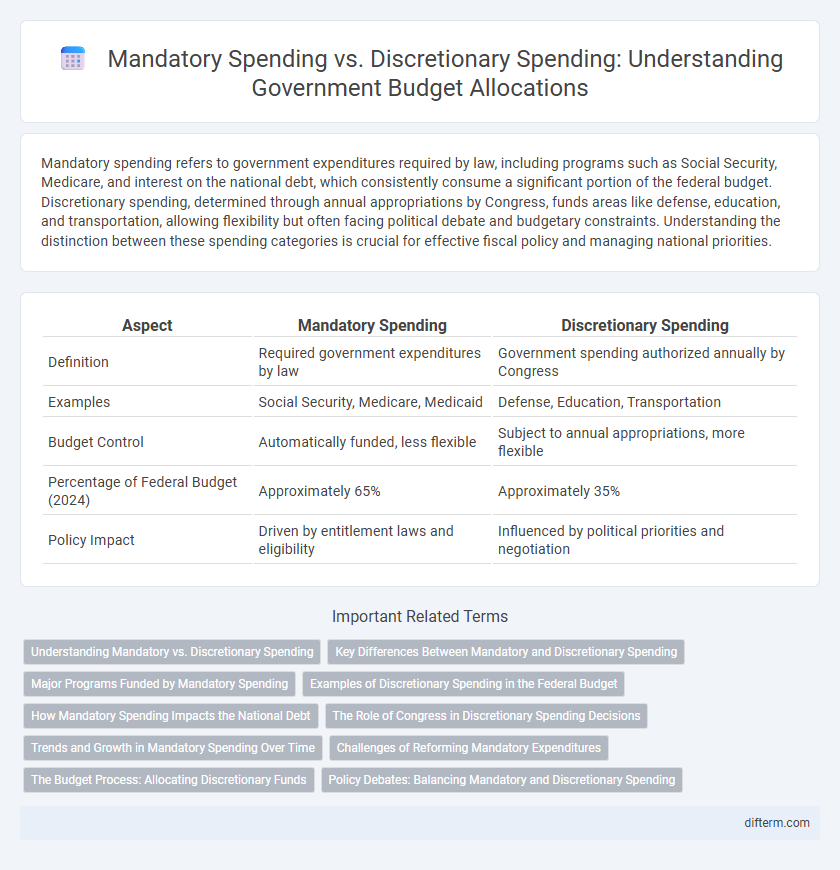Mandatory spending refers to government expenditures required by law, including programs such as Social Security, Medicare, and interest on the national debt, which consistently consume a significant portion of the federal budget. Discretionary spending, determined through annual appropriations by Congress, funds areas like defense, education, and transportation, allowing flexibility but often facing political debate and budgetary constraints. Understanding the distinction between these spending categories is crucial for effective fiscal policy and managing national priorities.
Table of Comparison
| Aspect | Mandatory Spending | Discretionary Spending |
|---|---|---|
| Definition | Required government expenditures by law | Government spending authorized annually by Congress |
| Examples | Social Security, Medicare, Medicaid | Defense, Education, Transportation |
| Budget Control | Automatically funded, less flexible | Subject to annual appropriations, more flexible |
| Percentage of Federal Budget (2024) | Approximately 65% | Approximately 35% |
| Policy Impact | Driven by entitlement laws and eligibility | Influenced by political priorities and negotiation |
Understanding Mandatory vs. Discretionary Spending
Mandatory spending in government budgets includes entitlement programs like Social Security, Medicare, and Medicaid, which are funded based on eligibility criteria and legal obligations. Discretionary spending covers areas such as defense, education, and transportation, where funding levels are determined annually through congressional appropriations. Understanding the distinction between these two spending types is crucial for analyzing fiscal policy and budgetary priorities.
Key Differences Between Mandatory and Discretionary Spending
Mandatory spending primarily consists of entitlement programs like Social Security, Medicare, and Medicaid, which are funded by law and require ongoing payments without annual approval. Discretionary spending, controlled through the annual budget process by Congress, includes funding for defense, education, and transportation, allowing for flexibility and adjustments each fiscal year. The key difference lies in the predictability and control: mandatory spending is largely fixed and driven by eligibility rules, while discretionary spending is subject to political decisions and budget negotiations.
Major Programs Funded by Mandatory Spending
Mandatory spending accounts for over two-thirds of the federal budget, primarily funding major programs like Social Security, Medicare, and Medicaid, which provide essential benefits to millions of Americans. These entitlements operate under statutory requirements, ensuring automatic funding without annual appropriations, unlike discretionary spending controlled through the congressional budget process. In 2023, mandatory spending totaled approximately $3.9 trillion, underscoring its critical role in sustaining social safety nets and healthcare services nationwide.
Examples of Discretionary Spending in the Federal Budget
Discretionary spending in the federal budget includes funding for defense, education, transportation, and scientific research. Programs such as the Department of Defense, the National Aeronautics and Space Administration (NASA), and the Department of Education are key examples of discretionary expenditures. These allocations are determined annually by Congress through the appropriations process, in contrast to mandatory spending like Social Security and Medicare.
How Mandatory Spending Impacts the National Debt
Mandatory spending, which includes Social Security, Medicare, and interest on the national debt, accounts for nearly two-thirds of the federal budget and significantly drives the growth of the national debt. Unlike discretionary spending, mandatory programs are legally required and automatically funded, limiting the government's ability to cut costs and manage deficits effectively. Persistent increases in mandatory spending contribute to higher borrowing needs, exacerbating the accumulation of national debt over time.
The Role of Congress in Discretionary Spending Decisions
Congress holds the constitutional authority to determine discretionary spending through the annual appropriations process, shaping budget allocations for defense, education, and transportation. This legislative control enables Congress to influence policy priorities and respond to changing national needs by adjusting funding levels. Unlike mandatory spending, which is governed by entitlement programs and requires less frequent adjustments, discretionary spending demands active congressional negotiation and approval each fiscal year.
Trends and Growth in Mandatory Spending Over Time
Mandatory spending, which includes programs such as Social Security, Medicare, and Medicaid, has experienced consistent growth over the past several decades due to rising entitlement enrollment and healthcare costs. This trend contrasts with discretionary spending, which is capped by annual budget decisions and has remained relatively stable or grown at a slower rate. Projections indicate mandatory spending will continue to consume a larger portion of federal expenditures, driven by demographic shifts like the aging population and inflation in medical services.
Challenges of Reforming Mandatory Expenditures
Reforming mandatory expenditures faces significant challenges due to their legal entitlements, such as Social Security and Medicare, which guarantee benefits to millions of Americans. These programs make up nearly two-thirds of the federal budget, limiting policymakers' flexibility to reduce spending without triggering widespread public backlash. Efforts to modify eligibility criteria or benefit formulas are often met with political resistance and complex economic implications, complicating attempts to control long-term fiscal deficits.
The Budget Process: Allocating Discretionary Funds
Discretionary spending is determined through the annual budget process, where Congress allocates funds for programs such as defense, education, and transportation based on current priorities and policy goals. Unlike mandatory spending, which is set by existing laws and includes entitlement programs like Social Security and Medicare, discretionary funds require annual approval and reflect shifting governmental objectives. The allocation process involves detailed appropriations bills debated and enacted by Congress, ensuring that discretionary resources align with legislative and executive strategies.
Policy Debates: Balancing Mandatory and Discretionary Spending
Policy debates center on balancing mandatory spending, which includes entitlement programs like Social Security and Medicare, with discretionary spending that funds defense, education, and infrastructure. Critics argue that rising mandatory costs constrain the government's ability to invest in priority areas through discretionary budgets. Proposals often focus on reforming mandatory programs or adjusting discretionary allocations to ensure fiscal sustainability and address shifting economic and social needs.
mandatory spending vs discretionary spending Infographic

 difterm.com
difterm.com